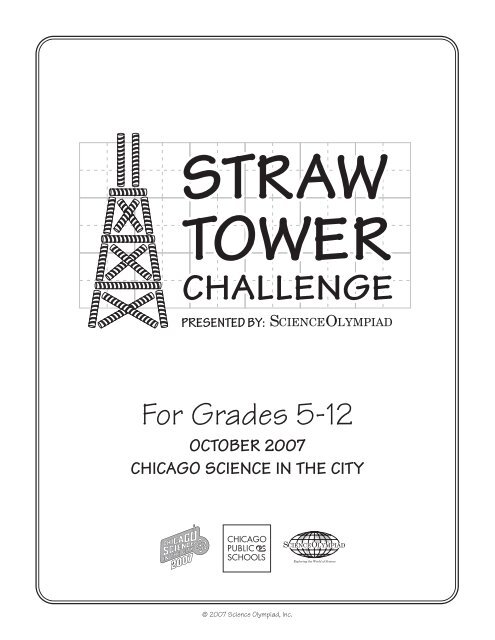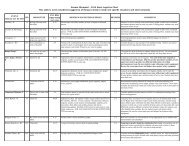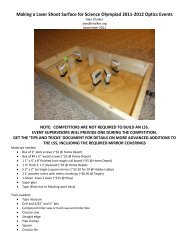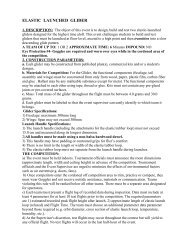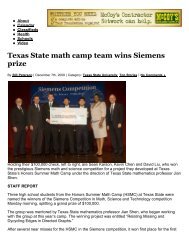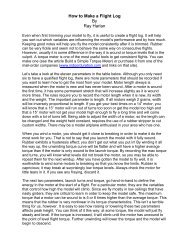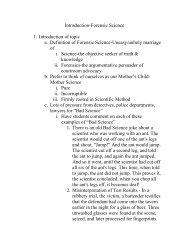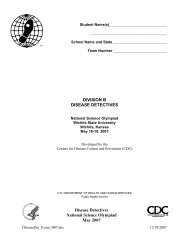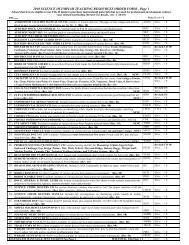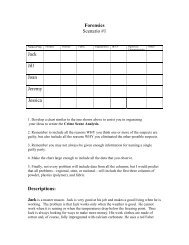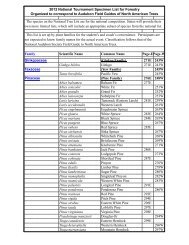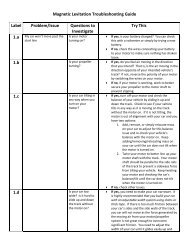Straw Tower Challenge - Science Olympiad
Straw Tower Challenge - Science Olympiad
Straw Tower Challenge - Science Olympiad
You also want an ePaper? Increase the reach of your titles
YUMPU automatically turns print PDFs into web optimized ePapers that Google loves.
STRAW<br />
TOWER<br />
CHALLENGE<br />
For Grades 5-12<br />
OCTOBER 2007<br />
CHICAGO SCIENCE IN THE CITY<br />
© 2007 <strong>Science</strong> <strong>Olympiad</strong>, Inc.
Arne Duncan<br />
Chief Executive Officer<br />
CHICAGO PUBLIC SCHOOLS<br />
David G. Gilligan<br />
Chief High School Officer<br />
Office of High Schools and High School Programs<br />
Department of High School Teaching & Learning · 125 South Clark Street, 12th Floor · Chicago, Illinois 60603<br />
Telephone 773/553-3540 · FAX 773/553-2148<br />
Michael C. Lach<br />
Officer<br />
Careda Taylor<br />
Chief of Staff<br />
Lydia C. Nantwi<br />
Gerod Sherley<br />
Administrators<br />
September 4, 2007<br />
Dear Teachers and Principals,<br />
The City of Chicago, in collaboration with a dynamic group of businesses, civic, cultural and community<br />
organizations is pleased to announce Chicago’s second annual Chicago <strong>Science</strong> in the City beginning the week of<br />
October 2, 2007. This two-week compilation of events is designed to encourage Chicagoans to explore and<br />
experience the various fields of science and to raise public awareness of the importance of science in our past,<br />
present and future. Last year’s expedition was very successful and brought together 1,500 participants and 5,000<br />
spectators to experience the kick-off event alone.<br />
As one way of supporting Chicago <strong>Science</strong> in the City: 2007, we have partnered with <strong>Science</strong> <strong>Olympiad</strong> to create<br />
the <strong>Straw</strong> <strong>Tower</strong> <strong>Challenge</strong>. For this <strong>Challenge</strong>, we are asking that teams of students in grades 5-12 build the<br />
tallest tower possible out of a limited supply of drinking straws and tape. These towers not only have to be tall but<br />
also they must support the weight of a tennis ball. Your school can publish its results, and track the progress of<br />
other schools, on the <strong>Straw</strong> <strong>Tower</strong> <strong>Challenge</strong> website. By participating in the <strong>Challenge</strong> your school is eligible to<br />
win various prizes as well as be invited to bring their towers to one of the Chicago <strong>Science</strong> in the City:<br />
Neighborhood <strong>Science</strong> Carnivals for a more public display of your work.<br />
To help you complete this <strong>Challenge</strong>, your school has been provided with two sets of tower building materials,<br />
this is enough material to involve approximately 25 to 30 students in the <strong>Challenge</strong>, and this booklet of lessons<br />
focusing on tower building and the engineering of structures. <strong>Science</strong> <strong>Olympiad</strong> designed these lessons to be used<br />
throughout the two weeks of Chicago <strong>Science</strong> in the City: 2007 either as part of the regularly scheduled classroom<br />
instruction or during after-school or at lunch “club” time. In addition, the College of Engineering at the University<br />
of Illinois Urbana-Champaign will be providing undergraduate engineering majors to help students as they design<br />
and build their towers. These engineering mentors will be “email pals” of the students and offer help and guidance<br />
as the students strive to create the tallest tower.<br />
If you have any questions, need additional materials, or need assistance implementing this activity, elementary<br />
schools should contact Ms. Chandra James, Office of Math & <strong>Science</strong> at 773-553-6192 and high schools should<br />
contact Dr. John F. Loehr, Department of High School Teaching and Learning at 773-535-8080 ext. 155.<br />
Thank you in advance for your cooperation to make this effort a success. The hard work and dedication you<br />
display are always appreciated.<br />
Sincerely,<br />
Michael C. Lach<br />
Children First
STRAW<br />
TOWER<br />
CHALLENGE<br />
STRAW TOWERS<br />
DESCRIPTION:<br />
To build the tallest tower out of 50 straws<br />
that will hold a designated load for 3 seconds.<br />
NUMBER OF PARTICIPANTS: 5-6<br />
APPROXIMATE TIME:<br />
120 minutes total over two weeks<br />
MATERIALS PROVIDED:<br />
Optional Materials:<br />
Scissors and a pencil; additional load items<br />
50 drinking straws, masking tape, tennis ball, measuring tape<br />
Event Parameters:<br />
1. The tower must be constructed using only the drinking straws and masking tape. There will be enough<br />
materials to build 3-5 towers.<br />
2. The straws can be interconnected directly by sliding one end into another straw. <strong>Straw</strong>s may be bent,<br />
cut or slit.<br />
3. Students may not completely cover their structure with masking tape as reinforcement; tape is used<br />
at joints only. Tape may not be used to secure the tower to a table, base, ceiling or surface. You may<br />
not make a leg, brace, cone or column out of tape.<br />
4. The tower must accommodate a standard tennis ball. The student must be able to balance the ball on<br />
the tower at the loading point for the tower to qualify.<br />
Measuring Your Achievement:<br />
1. Remember to measure your tower height before loading.<br />
2. The height of the tower will be measured again once the tennis ball is placed on the structure. Use a<br />
flat surface to test the structure.<br />
3. The tower that supports the load at the highest point is ranked first. If the tower does not support<br />
the load, it will be ranked BELOW the tower that did support the load based on tower height.<br />
4. Once you have collected the data on your schools’ towers please visit the Chicago <strong>Science</strong> in the City<br />
website and enter the data from the top 3 towers. In addition, pictures can be submitted by following<br />
the instructions posted at the site.<br />
The <strong>Science</strong> Behind Structures:<br />
1. Instructions for Teachers - Lists National and Illinois Standards alignment and tips for using this lesson plan.<br />
2. Extension Activities - Optional extensions for students.<br />
3. Implementation Schedule - A two-week calendar with suggested daily activities.<br />
4. <strong>Tower</strong> Log - Record observations and plan, design and evaluate your structure.<br />
5. <strong>Tower</strong> Sketch - A grid to plan your team’s design.<br />
6. Basic <strong>Tower</strong> Design - Covers legs, columns and bracing.<br />
7. Simple Structures - How shapes like triangles and squares form the parts of a tower.<br />
8. Analysis of Structures and Joints - Tips and engineering terms for joining your straws.<br />
Resources:<br />
<strong>Science</strong> in the City Homepage http://www.chicagoscienceinthecity.org/<br />
University of Illinois at Urbana-Champaign College of Engineering http://www.engr.uiuc.edu/<br />
Chicago Architecture Foundation http://www.architecture.org/<br />
<strong>Science</strong> <strong>Olympiad</strong> Home Page http://www.soinc.org/<br />
You may copy all of these<br />
pages for school use.<br />
PAGE - 1
STRAW<br />
TOWER<br />
CHALLENGE<br />
INSTRUCTIONS FOR TEACHERS<br />
With all the excitement surrounding the construction of several new skyscrapers in Chicago (the 92-story<br />
Trump International Hotel & <strong>Tower</strong>, Santiago Calatrava’s 2000-foot-tall Chicago Spire), the <strong>Science</strong> in the<br />
City “<strong>Straw</strong> <strong>Tower</strong> <strong>Challenge</strong>” reflects the rich architectural and engineering history of our great hometown.<br />
Your challenge as a teacher will be to turn a handful of straws and a roll of tape into a meaningful science<br />
activity. You might find skepticism among your students who will ask, “Can we really build a tall tower with<br />
straws?” But once presented with the materials, skyscrapers will arise from desks, floors and tabletops,<br />
reaching unexpected heights of creativity.<br />
We at <strong>Science</strong> <strong>Olympiad</strong> have provided you with a special set of instructions, containing a detailed daily<br />
calendar, extension activities for students, a tower log, a sketch sheet and four pages of engineering tips<br />
that will help you form the building blocks of a successful tower design. (Please feel free to copy these<br />
pages for your internal school use.) <strong>Science</strong> <strong>Olympiad</strong> takes pride in aligning all its events to National<br />
<strong>Science</strong> Standards as well as State Standards, and the <strong>Straw</strong> <strong>Tower</strong> <strong>Challenge</strong> meets both:<br />
STRAW TOWER BUILDING – The objective of this event is to design and build a straw tower with the<br />
highest structural efficiency capable of supporting a standard load. Teams should maintain and<br />
submit a log at check-in containing data to help them improve future designs.<br />
M.E.1.b-d<br />
E. <strong>Science</strong> and Technology – An understanding of science and technology establishes connections<br />
between the natural and designed world linking science and technology.<br />
M.E.1 Abilities of technological design<br />
b. Design a solution or product.<br />
c. Implement a proposed design.<br />
d. Evaluate completed technological designs or products.<br />
Illinois Learning Standard 11.B concerning knowledge and application of the concepts, principles and<br />
processes of technological design.<br />
Below are a few sample ways to utilize the following engineering tip pages. Be sure to have students record<br />
all observations in the <strong>Tower</strong> Log:<br />
Basic <strong>Tower</strong> Design - Ask students about towers they have seen that look like the Basic <strong>Tower</strong> Design<br />
drawing (cell phone towers, electricity towers, the John Hancock Building). Identify the main parts of a<br />
tower (legs, columns, braces). Explain the job of each per the handout.<br />
Simple Structures - Take a moment before the first lesson to assemble a few of the shapes with straws<br />
that will form the building blocks of a sample tower (square, triangle, pyramid and cube). Let the students<br />
touch and examine the shapes. Push, pull and bend the shapes to see how they react and analyze the<br />
strength of each shape. Discuss why triangles are stronger and show how they are used as reinforcing<br />
cross braces on towers. (How about making a column by bundling cables?)<br />
Analysis of Structures - Now illustrate the concepts of what will happen when you apply stress, pressure or<br />
a load to a tower. Use your shapes as a base and test with your hand or an object. What can students do<br />
in their design to reduce strain, stress, bending or shearing? Let each student experiment with a straw.<br />
Joints - Demonstrate and practice the proper way to wrap tape around the straws. Build a butt joint with<br />
adjoining straws for the longest section. Will it bend at the joint? Overlap the tips of two straws then<br />
tape. Is it stronger than the butt joint? Slip one straw into another and wrap the slip joint with tape. The<br />
section is shorter, but is it stronger? This exercise is vital to tower assembly and maximizing tower height.<br />
PAGE - 2
STRAW<br />
TOWER<br />
CHALLENGE<br />
EXTENSION ACTIVITIES<br />
Optional Extension Activities<br />
On all of these challenges, remember to take pictures and upload them to the <strong>Straw</strong> <strong>Tower</strong>s<br />
Photo Gallery located on the <strong>Science</strong> in the City website at www.chicagoscienceinthecity.org. The<br />
website also has a Leader Board which will continuously update your progress against other<br />
schools or classrooms within your school. See how your tower stacks up against the rest!<br />
University of Illinois College of Engineering “Ask A Student” E-Mail<br />
Program for <strong>Straw</strong> <strong>Tower</strong> <strong>Challenge</strong> - Chicago Public Schools students<br />
participating in the <strong>Straw</strong> <strong>Tower</strong> <strong>Challenge</strong> will be able to exchange<br />
emails with civil engineering students from the University of Illinois at Urbana-Champaign to ask<br />
questions and seek advice on their team projects. Simply access the <strong>Straw</strong> <strong>Tower</strong> <strong>Challenge</strong><br />
portion of the <strong>Science</strong> In The City website and click on “Ask A Student.” You will be directed to an<br />
email address of a UI administrator who will forward your email to an assigned mentor. CPS<br />
students will then directly communicate with the civil engineering students, who will also be<br />
attending the <strong>Science</strong> Carnivals on Saturday October 6 and 13 in the <strong>Science</strong> <strong>Olympiad</strong> booth.<br />
Build a Chicago Landmark out of straws - Test your skill at modeling by choosing a famous<br />
Chicago building and recreate it with straws! Start with an easy geometric shape like the Sears<br />
<strong>Tower</strong> or the Hancock <strong>Tower</strong> and move on to tougher assignments like the Water <strong>Tower</strong>, the<br />
Prudential Building or even the Frank Gehry-designed band shell at Millennium Park.<br />
Use other materials to test - Hit it out of the park! Instead of a tennis<br />
ball, test your structure with a baseball, mini basketball, football or<br />
volleyball. As you increase the load, think about the changes you will need<br />
to make to your structure to accommodate the additional weight. You can<br />
also place a cup on the top of your tower and add marbles, paper clips or<br />
pennies one by one to determine the quantity your structure will hold.<br />
Design your own <strong>Tower</strong> Log for The Cup <strong>Challenge</strong>.<br />
Use other materials to build - Don’t limit your imagination to drinking<br />
straws to build a tower. Use other materials you will commonly find around<br />
school or home, like cardboard, strips of wood, Tinker Toys, K’nex or LEGOS,<br />
to build your own creation.<br />
Average Weights of<br />
Common <strong>Straw</strong> <strong>Tower</strong>s<br />
Load Items:<br />
Penny 2.5g<br />
Ping Pong Ball 2.7g<br />
Quarter 5.7g<br />
Golf Ball 45g<br />
Tennis Ball 58g<br />
Apple 130g<br />
Baseball 145g<br />
Hockey Puck 162g<br />
Orange 288g<br />
Basketball 600g<br />
PAGE - 3
STRAW<br />
TOWER<br />
CHALLENGE<br />
IMPLEMENTATION SCHEDULE - OCTOBER 2007<br />
Monday Tuesday Wednesday Thursday Friday Saturday<br />
1 2 3 4 5 6<br />
20 minutes: IDENTIFY THE PROBLEM - Introduce activity and<br />
materials, set goals. Assemble student teams and assign jobs.<br />
Log on to the SITC web site. Discuss Basic <strong>Tower</strong> Design (p.7).<br />
Extension: Try to build a Chicago<br />
landmark out of straws.<br />
20 minutes: ANALYZE & GENERATE SOLUTIONS - Go over Simple<br />
Structures, Analysis of Structures and Joints (p. 8-10) and begin<br />
sketching out designs (p. 6). Work as a team to brainstorm shapes to<br />
hold the tennis ball atop your <strong>Straw</strong> <strong>Tower</strong> - grid, teepee, raft, shelf,<br />
basket, rooftop etc. Incorporate all ideas! Make sure you consider a way<br />
to stop the ball from rolling off. Use 10-15 straws to begin assembling<br />
2-D and 3-D shapes: squares, triangles, cubes, pyramids (p.8).<br />
10am - 2pm<br />
<strong>Science</strong> in the City<br />
Kickoff in<br />
Daley Plaza<br />
20 minutes: SELECT & PLAN SOLUTIONS - Settle on a design<br />
idea based on trial and error. Enter data into <strong>Tower</strong> Log (p.5) and<br />
begin testing weights on short structures. Build levels with<br />
remaining straws. Upload photos onto SITC web site.<br />
8 9 10 11 12 13<br />
<strong>Science</strong> in the City<br />
<strong>Science</strong> Carnival #1<br />
20 minutes: IMPLEMENT SOLUTION - Assemble multi-tiered or<br />
multi-level tower. Test load. Evaluate joints and discuss ways to<br />
use tape to make the strongest joints. Enter data into <strong>Tower</strong> Log.<br />
Extension: Use other materials<br />
to build your tower.<br />
20 minutes: EVALUATE SOLUTION - Make adjustments and<br />
record engineering and construction successes and failures in<br />
<strong>Tower</strong> Log. Finalize design and test. Take photos!<br />
Extension: Use other materials<br />
to test your tower.<br />
<strong>Science</strong> in the City<br />
<strong>Science</strong> Carnival #2<br />
20 minutes: Utilize Student and Teacher resources page.<br />
Compare your tower to others within your school to declare which<br />
is the tallest tower that holds the tennis ball. Finalize your <strong>Tower</strong><br />
Log and turn in to teacher. Upload final photo. Congratulations<br />
on building a <strong>Straw</strong> <strong>Tower</strong>!<br />
<strong>Science</strong> in the City<br />
<strong>Science</strong> Carnival #3<br />
Week 2<br />
Week 1<br />
PAGE - 4
STRAW<br />
TOWER<br />
CHALLENGE<br />
STRAW TOWER LOG<br />
Part One - Information Collected During Construction<br />
Date:<br />
School Name:<br />
Team Members<br />
<strong>Straw</strong> Boss:<br />
Architect:<br />
Engineer:<br />
Information Manager:<br />
Construction Workers:<br />
Number of <strong>Straw</strong>s Used:<br />
Number of Joints on <strong>Straw</strong> <strong>Tower</strong>:<br />
Sketch your design here and<br />
label the parts of your <strong>Straw</strong> <strong>Tower</strong><br />
Part Two - Information Collected During Testing<br />
Height of <strong>Tower</strong>:<br />
Height at top of tennis ball:<br />
Did the <strong>Straw</strong> <strong>Tower</strong> hold the tennis ball? Yes No<br />
Part Three - Information Collected After Testing<br />
How did the <strong>Straw</strong> <strong>Tower</strong> fail and what could you do to improve your design?<br />
Where did the <strong>Straw</strong> <strong>Tower</strong> fail? (list location of failure and ID on drawing above)<br />
What one thing would you change about the design next time?<br />
Jobs - Each member of the team should choose a job from the following list:<br />
<strong>Straw</strong> Boss - Serve as the Project Manager and supervise the project, making sure the job is getting<br />
built on time.<br />
Architect - Complete the drawings and sketch out the design of the tower.<br />
Engineer - Manages building the tower and testing the load.<br />
Information Manager - In charge of all information related to the construction project; complete the<br />
<strong>Tower</strong> Log and take photos of all progress.<br />
Construction Workers - Members of the crew will build all parts of the tower.<br />
PAGE - 5
STRAW<br />
TOWER<br />
CHALLENGE<br />
SKETCH YOUR TOWER<br />
PAGE - 6
STRAW<br />
TOWER<br />
CHALLENGE<br />
BASIC TOWER DESIGN<br />
Note to Teachers: The following four pages provide an overview of the components necessary to build<br />
successful <strong>Straw</strong> <strong>Tower</strong>s. Use these tips as instructional tools to correspond with the activities<br />
listed on the Instructions for Teachers on Page 2 and the Implementation Schedule on Page 4.<br />
The object is to support a load at some height above the base.<br />
A tower is made up of:<br />
Legs or Columns – Vertical members<br />
Extend from the base to the top of the tower<br />
Support the load<br />
Need to be strong in compression<br />
Bend easily because they are long and slender<br />
Cross Braces – Horizontal/Diagonal members<br />
Connect one leg to another<br />
“Break” the legs up into shorter and stronger members<br />
Prevent the legs from bending<br />
May be under compression or tension<br />
Have very little stress as long as the legs remain straight<br />
Load<br />
Cross braces<br />
Legs/Columns<br />
PAGE - 7
Square<br />
STRAW<br />
TOWER<br />
CHALLENGE<br />
SIMPLE STRUCTURES<br />
Use 4 drinking straws and tape to form a square. Stand the square on edge and apply a<br />
downward force to the top of it. The square deforms easily due to the weakness (in rotation) of<br />
the corner joints.<br />
Triangle<br />
Make a triangle in the same manner using 3 straws and tape and test it as you did the square.<br />
The triangle won’t change shape unless you push hard enough for either a joint or one of the<br />
straws to break.<br />
Fortunately a 4-sided figure can be changed into 2 triangles by connecting 2 opposite corners<br />
together. Add a rigid cross brace to the square and test it again. Now it is much stronger.<br />
Use squares and triangles as a base to form pyramids and cubes which will be the building blocks<br />
of your <strong>Straw</strong> <strong>Tower</strong>.<br />
PAGE - 8
STRAW<br />
TOWER<br />
CHALLENGE<br />
ANALYSIS OF STRUCTURES<br />
Definitions<br />
Joint – The place where 2 or more members are connected together.<br />
Member – A part of a structure that connects 2 joints.<br />
Strain – The deformation or change of shape that is the result of applied stress.<br />
Stress – The force applied to an object that tries to change its shape. There are 5 different<br />
forms of stress:<br />
Bending – Stress that tends to deform an object from a straight line.<br />
Compression – Stress that tends to compress an object together.<br />
Shear – Stress that tends to make two parts of an object slide past each other.<br />
Tension – Stress that tends to pull an object apart.<br />
Torsion – Stress that tends to twist an object around an axis.<br />
For our simplified analysis we will only consider bending, compression, and tension.<br />
PAGE - 9
STRAW<br />
TOWER<br />
CHALLENGE<br />
JOINTS<br />
A joint is where 2 or more members are joined together;<br />
Butt Joint – Pieces are joined end to end<br />
Butt Joint<br />
Lap Joint – Pieces are overlapped<br />
Lap Joint<br />
Slip Joint – One piece is slipped into the other<br />
Slip Joint<br />
The strength depends on the type of joint and material used to hold it together.<br />
You can use tape to hold butt and lap joints together.<br />
A lap joint can be held together with string or tape used as glue.<br />
Strength of Taped Joints<br />
Butt Joint<br />
Bending – Medium<br />
Compression – Strong<br />
Tension – Weak<br />
Lap Joint<br />
Bending – Medium<br />
Compression – Medium<br />
Tension – Medium<br />
Slip Joint<br />
Bending – Weak<br />
Compression – Medium<br />
Tension – Weak<br />
PAGE - 10


